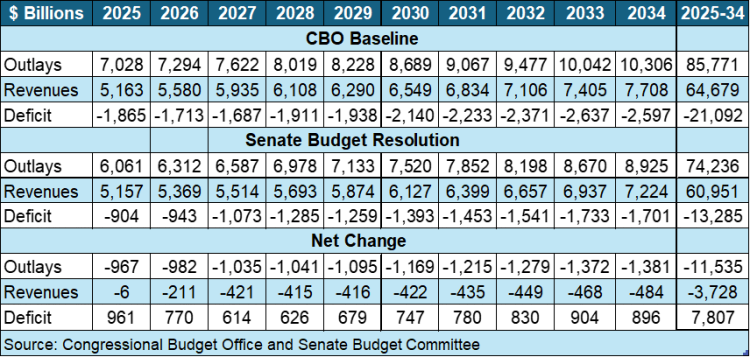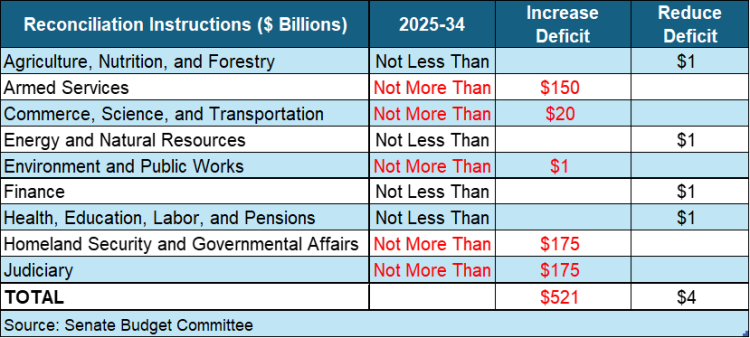This week the Senate Budget Committee is expected to markup a Congressional Budget Resolution for Fiscal Years 2025 through 2034. The Chairman’s mark to be considered by the Committee includes the recommended levels of spending, revenue, deficits, and debt over a ten-year period, as well as reconciliation instructions to the authorizing committees.
Relative to current law (baseline) projections of the Congressional Budget Office (CBO), the proposed budget resolution recommends a spending reduction of $11.5 trillion and revenue reduction of $3.7 trillion, resulting in net deficit reduction of $7.8 trillion over ten years.

At first glance, these numbers appear to suggest the Chairman’s mark proposes significant spending cuts, more than enough to offset the cost of extending the 2017 Tax Cuts and Jobs Act (TCJA). But a closer look reveals that’s just an illusion.
The budget resolution divides the recommended spending levels into twenty categories (Functions). More than three-fourths ($8.9 trillion) of the reductions ($11.5 trillion) are assigned to the “Allowance” category, or Function 920, which is a well-known magic asterisk used to show presumed savings from unidentified policies. Moreover, given the reconciliation instructions in the budget resolution, achieving these spending, revenue, and deficit reduction numbers are unlikely to be the intended result.
The most powerful role of any budget resolution (aside from allocating discretionary budget authority to the Appropriations Committee) is to create reconciliation instructions which allow expedited consideration of tax, spending, and debt-limit legislation that is exempt from the 60-vote threshold in the Senate.
The reconciliation instructions in the Chairman’s mark direct five of the authorizing committees to increase the deficit by no more than $521 billion. These instructions also direct four of the authorizing committees to reduce the deficit by no less than $4 billion. In theory, the former committees could spend less and the latter committees could save more, resulting in a budget neutral, or even deficit reducing reconciliation bill. However, the failure to direct the authorizing committees to find offsetting reductions suggests the Budget Committee has another goal in mind, which is revealed in the reconciliation instructions.

The reconciliation instructions contain a reserve fund that waives the 60-vote point of order against increasing the deficit by more than $10 billion over the 10-year budget period. Thus, any reconciliation bill that increases the deficit by $517 billion over 10 years could pass with a simple majority vote in the Senate. (The Byrd Rule would continue to apply a 60-vote point of order against any reconciliation bill that increases the deficit beyond the 10-year budget period.)
According to the press release issued by the Budget Committee, “The FY 2025 budget resolution will be the blueprint that unlocks the pathway for a fully paid for reconciliation bill to secure the border, bolster our military, increase American energy independence and begin the process of fiscal sanity.”
Admittedly, there is a pathway for a fully paid for reconciliation bill. But to paraphrase Robert Frost, when two pathways diverge in the woods, taking the one less traveled – by striking the reserve fund waiver – will make all the difference when it comes to restoring fiscal sanity.




